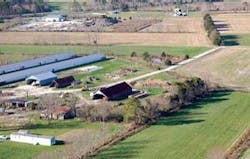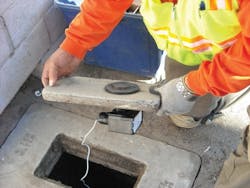Project Examines Floating Islands for Tertiary Nutrient Removal
By Archis Ambulkar, Stephen N. Zeller, and Douglas Klinger
Wiconisco Township, PA, owns and operates a 0.125 mgd secondary treatment plant with two lagoons which could be operated in series or in parallel. Each lagoon consists of two sections: completely aerated inlet section and a partially aerated second section resulting in facultative conditions.
In 2006, Brinjac Engineering helped the township obtain a Growing Greener Innovative Wastewater Treatment Grant Award for $65,000 to install floating islands for tertiary nutrient removal at the wastewater treatment plant. In addition, in 2008 Brinjac helped the township obtain an $84,000 grant from the State of Pennsylvania for Growing Greener II Innovative and Alternative wastewater treatment carbon footprint reduction projects. That project involved installation of solar powered circulators to improve primary and secondary treatment in the lagoons.
Floating Islands
Floating islands are a natural treatment system mainly consisting of an artificial buoyant matrix that floats on the water surface with macrophytes (woody plants) and grasses planted on the island for removing nutrients from wastewater.
The surface of the floating island is porous enough to allow plant roots to penetrate through the matrix into the water column, facilitating nutrient uptake through the roots and bacteria which grow on the roots. As an added benefit, the vegetation helps to cool the surface of the water column and block sunlight which helps control algae. The vegetation also gives off oxygen during daylight and CO2 at night. Uptake of nutrients by the roots/bacteria removes nitrogen from the water. Once the plants uptake nitrogen, it is in a completely fixed form and no longer available as a pollutant.
In November 2006 the Wiconisco Township installed three BioHavens floating island wetlands units, each 250 square feet, from Floating Island International. The islands were installed in Lagoon #2 downstream of the facultative zone aerator to improve nutrient uptake. BioHaven floating islands are buoyant mats, planted like a garden and launched onto a waterway. They are made from a matrix of fibers made from 100% recycled plastic. Layers of matrix are bonded together with foam, which also provides buoyancy.
The floating island system included a solar powered pump capable of lifting water from under the islands and discharging on top of islands to ensure all the wetlands plants thrived in a moist environment, solar panels to power the fractional horsepower pumps, and wind powered aerators with aeration stones capable of providing aeration based on wind driven energy.
The islands were seeded with various plant species such as Cosmos Sedge, Lurid's Sedge, Blue Flag Iris, Soft Stem Bulrush, Woolgrass, Soft Rush, Canada Rush, Buttonbush and Winter Berry.
Operational data comparison between the facility's two lagoons from November 2006 through January 2009 indicated the islands helped reduce average effluent Total Nitrogen (TN) concentration by about 1.7 mg/l compared to the lagoon without floating islands. That resulted in an estimated annual effluent TN load reduction of 310 lbs of total nitrogen based on the average flows of 0.060 mgd over the period. However, no significant improvements were observed in the average effluent total phosphorus concentrations.
The TN reduction was more evident around 10 months after installation, probably due to growth of vegetation and plant roots over this period. Considering the three islands occupied only 2-4% of total lagoon surface area for the study, the system showed potential for process improvements with respect to nutrient removal from wastewater if larger units are installed.
Solar Circulators
In March 2009, the Township installed one SolarBee® solar powered circulator in Lagoon #1 and two in Lagoon #2. The machines are capable of bringing water up from a desired depth and transporting it horizontally long distances across the water surface. The intent was to gradually replace grid-powered aeration units.
Considering the water circulation provided by the solar units, the upgraded system was expected to operate somewhere between aerated lagoons and facultative lagoons, providing both reduced energy consumption and improvements in system performance.
Since the flow pattern and the biology in the lagoons changed to a completely circulated lagoon system with the new circulators, sludge that had settled in the lagoons was raised and distributed. This phenomenon was observed by increased nutrients in the treatment system followed by reduction in system dissolved oxygen due to the oxygen demand for this additional nutrient load.
During the transition from mechanical aeration units to SolarBee system operations, 50% of the existing aerators were operated 24/7 to help keep the DO elevated until the system stabilized. As a result, the WWTP remained in compliance with its NPDES Permit during the commissioning process.
One year operational data from March 2009 to February 2010 demonstrated process improvements with respect to TSS and Fecal Coliform removal and reduction in algae formation. Process improvements were accompanied by reduction in monthly energy consumption by about 47% and corresponding reduction in average monthly electric costs by about 32%. This resulted in carbon footprint reduction by 47% as well.
Overall, the solar circulator system upgrades provided the necessary wastewater treatment and served as a suitable option for minimizing energy consumption, operational costs and meeting WWTP permit limits.
WW
About the Authors: Archis Ambulkar is an Environmental Engineer with Brinjac Engineering, based in Harrisburg, PA. Stephen N. Zeller is Project Manager at Brinjac. Douglas Klinger is a Plant Operator at the Wiconisco Wastewater Treatment Plant.
More WaterWorld Current Issue Articles
More WaterWorld Archives Issue Articles


